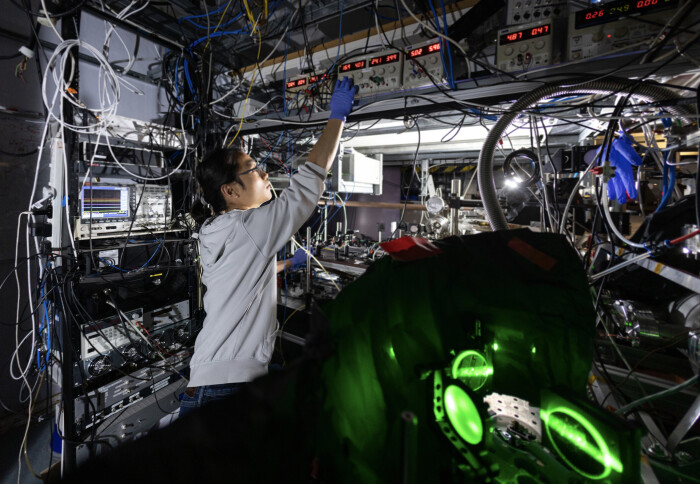Imperial's five quirky quantum leaps of 2023

From creating new navigation systems to remixing old experiments, here are Imperial's top five quantum moments from 2023.
Throughout 2023 Imperial has had many quantum breakthroughs. From wavefunction experiments to satellite-free navigation systems, this is 2023’s round-up of quantum research at Imperial and how it’s making its way out of the lab.
Quantum science and transforming technologies

Quantum communication may one day ensure secure and un-hackable data transmission through new encryption methods. Quantum sensors could enable highly precise measurements, impacting fields from healthcare to environmental monitoring.
Imperial is making the advancements and interdisciplinary collaborations needed to harness the full potential of quantum science for societal and industrial progress.
We interviewed Imperial's top quantum experts in this Q&A to explore how quantum technologies could shape the future.
Quantum sensor for a future navigation system tested aboard Royal Navy ship
The last decade has seen a rise in the development of self-contained, satellite-free navigation systems. While multiple such systems have been created, they exhibit a ‘drift’, which lowers their accuracy and efficiency.
Dr Joseph Cotter from the Department of Physics is helping to combine quantum sensors with classical mechanics to create a satellite-free quantum navigation system.

Dr Cotter’s lab collaborated with the Royal Navy to test if Imperial's quantum sensor worked in the real-world environment.
Dr Cotter said the field experiment showed that “we have these sensors and that they can do useful things” and “the aim now is to actually position them in the real-world”.
Co-lead Dr Aisha Kaushik says that the lab is now working to make their quantum technology adaptable to the world beyond the lab: “Testing it to see what it can do outside... you end up finding a lot of problems. It challenges you to work a lot more quickly.”
Double-slit experiment that proved the wave nature of light explored in time
Imperial physicists remixed the famous double-slit experiment, which was originally performed in 1801 to demonstrate that quantum particles could behave like waves as well as particles.

The original double-slit experiment involved passing individual photons through an opaque screen with two thin parallel slits in it. A detector is placed behind the screen to measure the photons as they travel through.
The wave-like behaviour of photons allowed them to pass through both slits at the same time, creating an ‘interference pattern’ on the detector.
Imperial’s new experiment, led by Professor Riccardo Sapienza from the Department of Physics, created ‘slits in time’. Photons were shot through a material that rapidly changed its properties in femtoseconds (quadrillionths of a second).
In response, scientists observed that the photons changed their frequencies, revealing more mysteries about the fundamental nature of light.
JUICE magnetometer passes fitness tests and is ready to take data

Imperial’s researchers successfully developed and tested a magnetometer instrument designed for the European Space Agency's JUICE (JUpiter ICy moons Explorer) mission.
The magnetometer's role is crucial in analysing the magnetic fields around Jupiter’s icy moons, providing valuable insights into their composition and internal structures. Its quantum interferometer, labelled J-MAG, can give scientists ultra-precise measurements of lunar magnetic field strengths.
The magnetometer underwent rigorous testing to ensure it can withstand the extreme temperatures and intense radiation on its space voyage.
An Ariane 5 rocket carrying Imperial’s magnetometer took off in April 2023 and is expected to reach Jupiter’s moon Ganymede in 2034.
New quantum technologies centre paves UK’s quantum future
The Centre for Quantum Engineering, Science and Technology (QuEST) was launched in 2023 and is now focused on creating advanced quantum devices and tools.

QuEST focuses on various areas, such as quantum computing, sensors and communication.
Its scientists have already achieved breakthroughs in designing quantum sensors with enhanced sensitivity and precision, paving the way for applications in medical imaging, environmental monitoring and beyond.
QuEST also aims to foster collaborations between academia and industry to accelerate the translation of these quantum advancements into real-world technologies, showcasing the potential for significant impacts across multiple sectors.
Article text (excluding photos or graphics) © Imperial College London.
Photos and graphics subject to third party copyright used with permission or © Imperial College London.
Reporter
Jacklin Kwan
Faculty of Natural Sciences
Alexandra Epshtein
Communications Division